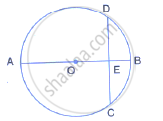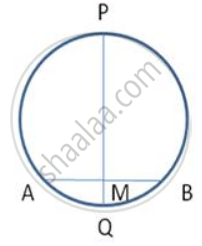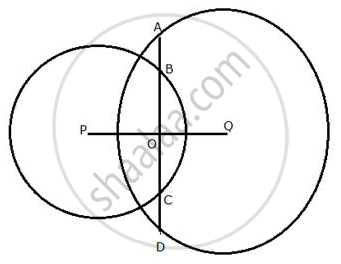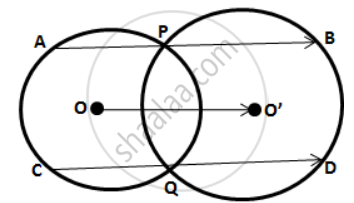Advertisements
Advertisements
Question
In the following figure, a circle is inscribed in the quadrilateral ABCD.

If BC = 38 cm, QB = 27 cm, DC = 25 cm and that AD is perpendicular to DC, find the radius of the circle.
Solution
From the figure we see that BQ = BR = 27 cm ...(Since length of the tangent segments from an external point are equal)
As BC = 38 cm
`=>` CR = CB − BR
= 38 − 27
= 11 cm
Again,
CR = CS = 11 cm ...(Length of tangent segments from an external point are equal)
Now, as DC = 25 cm
∴ DS = DC − SC
= 25 − 11
= 14 cm
Now, in quadrilateral DSOP,
∠PDS = 90° ...(Given)
∠OSD = 90°, ∠OPD = 90° ...(Since tangent is perpendicular to the
radius through the point of contact)
`=>` DSOP is a parallelogram
`=>` OP || SD and PD || OS
Now, as OP = OS ...(Radii of the same circle)
`=>` OPDS is a square.
∴ DS = OP = 14 cm
∴ Radius of the circle = 14 cm
APPEARS IN
RELATED QUESTIONS
A chord of length 6 cm is drawn in a circle of radius 5 cm. Calculate its distance from the centre of the circle.
The figure given below, shows a circle with centre O in which diameter AB bisects the chord CD at point E. If CE = ED = 8 cm and EB = 4cm, find the radius of the circle.

Two chords of lengths 10cm and 24cm are drawn parallel o each other in a circle. If they are on the same side of the centre and the distance between them is 17cm, find the radius of the circle.
In following figure , AB , a chord of the circle is of length 18 cm. It is perpendicularly bisected at M by PQ.

A chord of length 8 cm is drawn at a distance of 3 cm from the center of the circle.
Calculate the radius of the circle.
In the following figure, the line ABCD is perpendicular to PQ; where P and Q are the centers of the circles.
Show that:
(i) AB = CD ;
(ii) AC = BD.
In the following figure; P and Q are the points of intersection of two circles with centers O and O'. If straight lines APB and CQD are parallel to OO';
prove that: (i) OO' = `1/2`AB ; (ii) AB = CD
Two chords AB and CD of a circle are parallel and a line L is the perpendicular bisector of AB. Show that L bisects CD.
AB is a diameter of a circle with centre C = (- 2, 5). If A = (3, – 7). Find
(i) the length of radius AC
(ii) the coordinates of B.
AB and CD are two parallel chords of a circle such that AB = 10 cm and CD = 24 cm. If the chords are on the opposite sides of the centre and the distance between them is 17 cm, find the radius of the circle.
